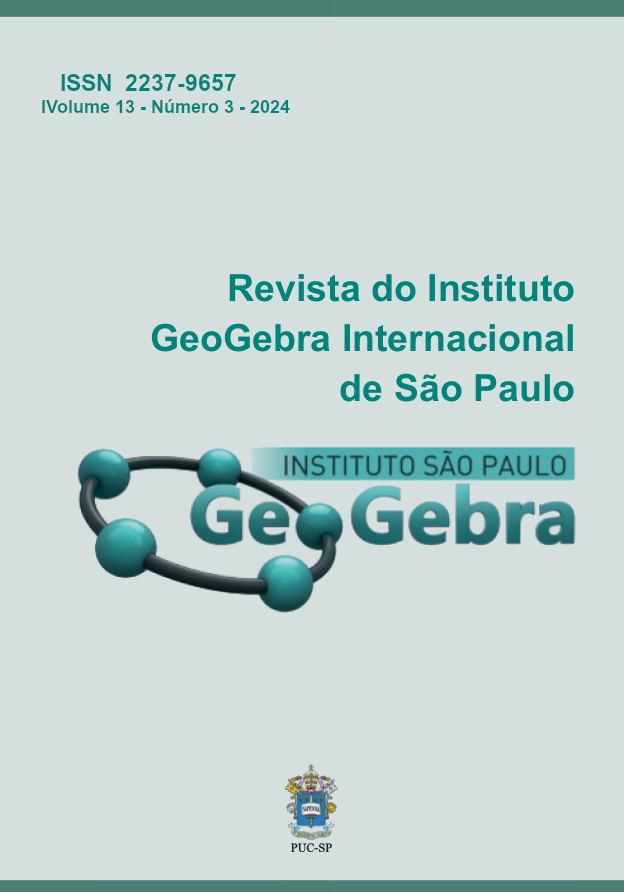Use of GeoGebra to facilitate the understanding of the definitions of amplitude, period and phase diagram of the graphs of the trigonometric functions’ sine and cosine
DOI:
https://doi.org/10.23925/2237-9657.2024.v13i3p005-026Keywords:
GeoGebra, sine, cosineAbstract
The objective of this work is to improve the compression of the definitions of amplitude, period and phase diagram of the trigonometric sine and cosine functions, using the GeoGebra software. The Methodology was carried out with a qualitative-quantitative approach, in which a couple of surveys were used for the students of the course: a) the first (Pre-test), which was applied at the end of the class where the definitions were studied of amplitude, period and phase shift of the graphs of the sine and cosine functions, applying a static geometric system (SGE) b) the second (Post-test) that was filled out by the students, once they carried out some activities that involved the previously mentioned concepts, but with the help of the GeoGebra software, which is a representative of a dynamic geometric system (DGS). It was possible to encourage students to use GeoGebra in their future teaching practice, the latter is very well supported in the positive response that all students expressed in a Post-test question.
References
Alexis, P. (2016). Nota científica. La trigonometría: Dificultades existentes en el proceso enseñanza- aprendizaje. Revista Colón Ciencias, Tecnologías y Negocios, 3(1), 36-43. http://up-rid.up.ac.pa/3097/
Cabrera S., Lisbeth P. y Alba L. (2023). Análisis del Marco de Referencia PISA 2022. Foco Atención Matemática. Departamento de Evaluación. Instituto Dominicano de Evaluación e Investigación de la Calidad Educativa. https://ideice.gob.do/documentacion/publicaciones-msg-set-id-1-art-p1-181-analisis-del-marco-de-referencia-pisa-2022-foco-atencion-matematicas
Díaz, M. (2014). Enseñanza de la trigonometría en 4o de la ESO con GeoGebra [Fin de Máster, Universidad Internacional de la Rioja]. Facultad de Educación. https://reunir.unir.net/bitstream/handle/123456789/2426/diaz.fernandez.pdf?sequence=1
Hernández-Sampieri, R., y Mendoza, C. (2018). Metodología de la investigación. Las rutas
cuantitativa, cualitativa y mixta. McGraw Hill: México .http://www.biblioteca.cij.gob.mx/Archivos/Materiales_de_consulta/Drogas_de_Abuso/Articulos/SampieriLasRutas.pdf
Jácome, G. y Montiel, G. (2007). Memoria de la XI Escuela de Invierno de Matemática Educativa. Red Cimates. Pp. 433-436. http://up-rid.up.ac.pa/3097/
Posada-Acosta, M. G., Matilla-Arias, J., y Rosales-Sáez, F. (2017). Potencialidades del software GeoGebra en la enseñanza de la matemática: estudio de caso de su aplicación en la trigonometría. Roca. Revista científico - Educacional De La Provincia Granma, 13(4), 401-415. https://revistas.udg.co.cu/index.php/roca/article/view/300
Padilla-Escorcia, I. A., y Acevedo-Rincón, J. P. (2021). Conocimiento especializado del profesor que enseña la reflexión de la función trigonométrica: mediaciones con TIC. Eco Matemático, 12(1), 93–106. https://doi.org/10.22463/17948231.3072
Trípoli, M., Torroba P., Devece E. y Aquilano, L. (2019). Funciones trigonométricas, periódicas y oscilatorias: Una propuesta interdisciplinaria. Quinta Jornadas ITE. Facultad de ingeniería UNLP, pp. 166-171.
Zill, D y Dewar, J. (2012). Álgebra, trigonometría y geometría analítica. Tercera edición. Mc Graw Hill., 12 (1), 73-112, 1992.
Downloads
Published
How to Cite
Issue
Section
License
Copyright (c) 2024 Journal of the GeoGebra International Institute of São Paulo

This work is licensed under a Creative Commons Attribution 4.0 International License.
Submission, processing, and publication of articles sent to the journal and registration of the DOI at Crossref is free of charge.
Authors retain their copyright and grant the journal the right of first publication of their article, which is simultaneously licensed under a Creative Commons - Attribution 4.0 International license CC BY that allows others to share the article by acknowledging its authorship and initial publication by the journal.
The GeoGebra journal encourages its authors to register their work with information and communication management systems aimed at researchers, such as Academia.edu, Mendeley, ResearchGate, etc.


 10.23925
10.23925
